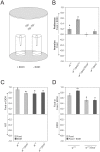Neuronal basis of innate olfactory attraction to ethanol in Drosophila
- PMID: 23284851
- PMCID: PMC3527413
- DOI: 10.1371/journal.pone.0052007
Neuronal basis of innate olfactory attraction to ethanol in Drosophila
Abstract
The decision to move towards a mating partner or a food source is essential for life. The mechanisms underlying these behaviors are not well understood. Here, we investigated the role of octopamine - the invertebrate analogue of noradrenaline - in innate olfactory attraction to ethanol. We confirmed that preference is caused via an olfactory stimulus by dissecting the function of the olfactory co-receptor Orco (formally known as OR83b). Orco function is not required for ethanol recognition per se, however it plays a role in context dependent recognition of ethanol. Odor-evoked ethanol preference requires the function of Tbh (Tyramine β hydroxalyse), the rate-limiting enzyme of octopamine synthesis. In addition, neuronal activity in a subset of octopaminergic neurons is necessary for olfactory ethanol preference. Notably, a specific neuronal activation pattern of tyraminergic/octopaminergic neurons elicit preference and is therefore sufficient to induce preference. In contrast, dopamine dependent increase in locomotor activity is not sufficient for olfactory ethanol preference. Consistent with the role of noradrenaline in mammalian drug induced rewards, we provide evidence that in adult Drosophila the octopaminergic neurotransmitter functions as a reinforcer and that the molecular dissection of the innate attraction to ethanol uncovers the basic properties of a response selection system.
Conflict of interest statement
Figures






Similar articles
-
Characterization of the octopaminergic and tyraminergic neurons in the central brain of Drosophila larvae.J Comp Neurol. 2014 Oct 15;522(15):3485-500. doi: 10.1002/cne.23616. Epub 2014 May 13. J Comp Neurol. 2014. PMID: 24752702
-
Octopamine Shifts the Behavioral Response From Indecision to Approach or Aversion in Drosophila melanogaster.Front Behav Neurosci. 2018 Jul 3;12:131. doi: 10.3389/fnbeh.2018.00131. eCollection 2018. Front Behav Neurosci. 2018. PMID: 30018540 Free PMC article.
-
Induction of associative olfactory memory by targeted activation of single olfactory neurons in Drosophila larvae.Sci Rep. 2014 Apr 25;4:4798. doi: 10.1038/srep04798. Sci Rep. 2014. PMID: 24762789 Free PMC article.
-
The neuro-ecology of resource localization in Drosophila: behavioral components of perception and search.Fly (Austin). 2009 Jan-Mar;3(1):50-61. doi: 10.4161/fly.3.1.7775. Epub 2009 Jan 6. Fly (Austin). 2009. PMID: 19218831 Review.
-
The olfactory sensory map in Drosophila.Adv Exp Med Biol. 2008;628:102-14. doi: 10.1007/978-0-387-78261-4_7. Adv Exp Med Biol. 2008. PMID: 18683641 Review.
Cited by
-
Peptidoglycan-dependent NF-κB activation in a small subset of brain octopaminergic neurons controls female oviposition.Elife. 2019 Oct 29;8:e50559. doi: 10.7554/eLife.50559. Elife. 2019. PMID: 31661076 Free PMC article.
-
Genetics and genomics of alcohol responses in Drosophila.Neuropharmacology. 2017 Aug 1;122:22-35. doi: 10.1016/j.neuropharm.2017.01.032. Epub 2017 Feb 1. Neuropharmacology. 2017. PMID: 28161376 Free PMC article. Review.
-
Heterogeneity in the projections and excitability of tyraminergic/octopaminergic neurons that innervate the Drosophila reproductive tract.Front Mol Neurosci. 2024 Aug 2;17:1374896. doi: 10.3389/fnmol.2024.1374896. eCollection 2024. Front Mol Neurosci. 2024. PMID: 39156129 Free PMC article.
-
Calcium levels in ASER neurons determine behavioral valence by engaging distinct neuronal circuits in C. elegans.Nat Commun. 2025 Feb 20;16(1):1814. doi: 10.1038/s41467-025-57051-x. Nat Commun. 2025. PMID: 39979341 Free PMC article.
-
A comprehensive anatomical map of the peripheral octopaminergic/tyraminergic system of Drosophila melanogaster.Sci Rep. 2018 Oct 17;8(1):15314. doi: 10.1038/s41598-018-33686-3. Sci Rep. 2018. PMID: 30333565 Free PMC article.
References
-
- Ogueta M, Cibik O, Eltrop R, Schneider A, Scholz H (2010) The influence of Adh function on ethanol preference and tolerance in adult Drosophila melanogaster. Chem Senses 35: 813–822. - PubMed
-
- Zhu J, Park KC, Baker TC (2003) Identification of odors from overripe mango that attract vinegar flies, Drosophila melanogaster. J Chem Ecol 29: 899–909. - PubMed
-
- McKenzie JA, Parsons PA (1972) Alcohol Tolerance - Ecological Parameter in Relative Success of Drosophila-Melanogaster and Drosophila-Simulans. Oecologia 10: 373-&. - PubMed
-
- Dierks A, Fischer K (2008) Feeding responses and food preferences in the tropical, fruit-feeding butterfly, Bicyclus anynana. J Insect Physiol 54: 1363–1370. - PubMed
-
- Larsson MC, Domingos AI, Jones WD, Chiappe ME, Amrein H, et al. (2004) Or83b encodes a broadly expressed odorant receptor essential for Drosophila olfaction. Neuron 43: 703–714. - PubMed
Publication types
MeSH terms
Substances
LinkOut - more resources
Full Text Sources
Molecular Biology Databases

